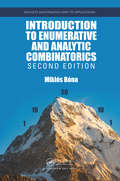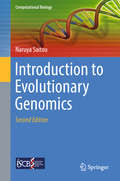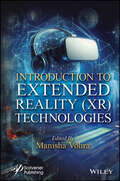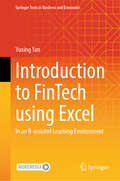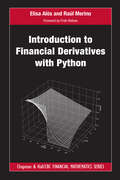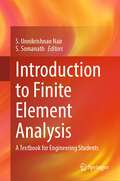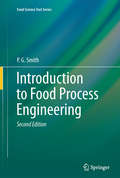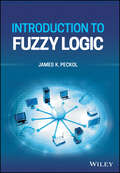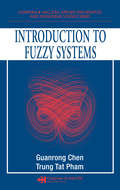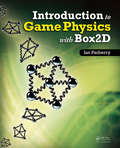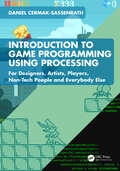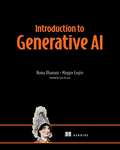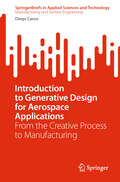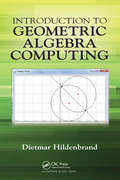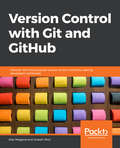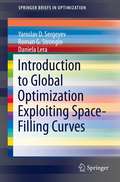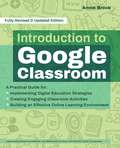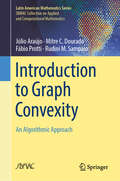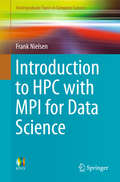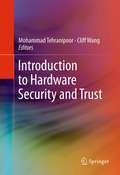- Table View
- List View
Introduction to Enumerative and Analytic Combinatorics (Discrete Mathematics and Its Applications)
by Miklos BonaIntroduction to Enumerative and Analytic Combinatorics fills the gap between introductory texts in discrete mathematics and advanced graduate texts in enumerative combinatorics. The book first deals with basic counting principles, compositions and partitions, and generating functions. It then focuses on the structure of permutations, graph enumerat
Introduction to Environmental Data Analysis and Modeling (Lecture Notes in Networks and Systems #58)
by Esther Titilayo Akinlabi Moses Eterigho EmetereThis book introduces numerical methods for processing datasets which may be of any form, illustrating adequately computational resolution of environmental alongside the use of open source libraries. This book solves the challenges of misrepresentation of datasets that are relevant directly or indirectly to the research. It illustrates new ways of screening datasets or images for maximum utilization. The adoption of various numerical methods in dataset treatment would certainly create a new scientific approach. The book enlightens researchers on how to analyse measurements to ensure 100% utilization. It introduces new ways of data treatment that are based on a sound mathematical and computational approach.
Introduction to Evolutionary Genomics (Computational Biology #Vol. 17)
by Naruya SaitouThis authoritative textbook/reference presents a comprehensive introduction to the field of evolutionary genomics. The opening chapters describe the fundamental concepts in molecular biology and genome evolution for readers without any prior background in this area. This is followed by a detailed examination of genome evolution in various different groups of organisms. The text then concludes with a review of practical methods essential to researchers in the field.This updated and revised new edition also features historical perspectives on contributions to evolutionary genomics from related fields such as molecular evolution, genetics, and numerical taxonomy.Topics and features: introduces the basics of molecular biology, covering protein structure and diversity, as well as DNA replication, transcription, and translation; examines the phylogenetic relationships of DNA sequences, and the processes of mutation, neutral evolution, and natural selection; presents a brief evolutionary history of life, surveying the key features of the genomes of prokaryotes, eukaryotes, viruses and phages, vertebrates, and humans; reviews the various biological “omic” databases, and discusses the analysis of homologous nucleotide and amino acid sequences; provides an overview of the experimental sequencing of genomes and transcriptomes, and the construction of phylogenetic trees; describes methods for estimating of evolutionary distances, and performing studies of population genetics; supplies additional supporting material at an associated website.Serving as an indispensable textbook for graduate and advanced undergraduate courses on evolutionary genomics, this accessible overview will also prove invaluable to researchers from both computer science and the biological sciences seeking a primer on the field.
Introduction to Excel and SPSS: A Stepwise Approach to Statistical Software
by Susan D. Croll Michelle L. FowlerIntroduction to Excel and SPSS: A Stepwise Approach to Statistical Software by Susan D. Croll and Michelle L. Fowler
Introduction to Extended Reality (XR) Technologies
by Manisha VohraThis book is a comprehensive overview of the fundamentals and applications of extended reality (XR) with practical insights and real-world examples. Introduction to Extended Reality (XR) Technologies is a thorough guide to understanding the fundamentals, concepts, and key aspects of XR technology, including augmented reality (AR), virtual reality (VR), and mixed reality (MR). The book explores how extended reality blends the physical and virtual worlds, transforming industries such as education, healthcare, and entertainment. Each chapter covers key aspects, from foundational principles to practical applications, with real-world examples illustrating the technologies’ potential. By addressing current trends, challenges, and future directions, the book serves as an essential resource to explore the evolving world of these technologies. This book comprises 12 chapters, each presenting an in-depth overview of extended reality (XR) technologies. The first section details an introduction to extended reality technologies, covering augmented reality (AR), virtual reality (VR), and mixed reality (MR), and how they’re rapidly growing across various industries. The second section examines the potential of these technologies and how they’ll revolutionize different sectors, like aviation and tourism. The section also includes discussions on specific applications of XR technologies and the development advantages for each sector. The third section discusses how augmented reality and virtual reality play a pivotal role in healthcare sectors, allowing for disease diagnosis and treatment planning. Audience This book is intended for engineers, IT industry professionals, healthcare industry professionals, computer engineering and the electronics sector.
Introduction to FinTech using Excel: In an R-assisted Learning Environment (Springer Texts in Business and Economics)
by Yuxing YanThis book serves as a bridge, leveraging the familiarity of Excel and the power of R to make FinTech accessible to all. Financial Technology (FinTech) has revolutionized areas once dominated by traditional finance. However, the need to learn a programming language often creates a barrier for many learners. Excel-based learning builds confidence with tools that are already familiar to advanced students, while minimal R programming is required—no prior R skills needed, just two simple lines of code. Hidden functions unlock powerful FinTech capabilities with ease. With this book, students can learn to generate public and private keys effortlessly,create a Hash for any given phrase, use the Merkle Tree to combine 100 transactions into a block's Hash, develop QR codes for websites or public keys, verify (x,y) values on the Elliptic curve for cryptography, and run models for both Unsupervised and Supervised Learning. The book includes definitions, exercises, and solutions for students to develop the skills to navigate and excel in the world of FinTech.
Introduction to Financial Derivatives with Python (Chapman and Hall/CRC Financial Mathematics Series)
by Elisa Alòs Raúl MerinoIntroduction to Financial Derivatives with Python is an ideal textbook for an undergraduate course on derivatives, whether on a finance, economics, or financial mathematics programme. As well as covering all of the essential topics one would expect to be covered, the book also includes the basis of the numerical techniques most used in the financial industry, and their implementation in Python. Features Connected to a Github repository with the codes in the book. The repository can be accessed at https://bit.ly/3bllnuf Suitable for undergraduate students, as well as anyone who wants a gentle introduction to the principles of quantitative finance No pre-requisites required for programming or advanced mathematics beyond basic calculus
Introduction to Finite Element Analysis: A Textbook for Engineering Students
by S. Unnikrishnan Nair S. SomanathThis textbook covers the basic concepts and applications of finite element analysis. It is specifically aimed at introducing this advanced topic to undergraduate-level engineering students and practicing engineers in a lucid manner. It also introduces a structural and heat transfer analysis software FEASTSMT which has wide applications in civil, mechanical, nuclear and automobile engineering domains. This software has been developed by generations of scientists and engineers of Vikram Sarabhai Space Centre and Indian Space Research Organisation. Supported with many illustrative examples, the textbook covers the classical methods of estimating solutions of mathematical models. The book is written in an easy-to-understand manner. This textbook also contains numeral exercise problems to aid self-learning of the students. The solutions to these problems are demonstrated using finite element software. Furthermore, the textbook contains several tutorials and associated online resources on usage of the FEASTSMT software. Given the contents, this textbook is highly useful for the undergraduate students of various disciplines of engineering. It is also a good reference book for the practicing engineers.
Introduction to Food Process Engineering
by P. G. SmithThis is a new book on food process engineering which treats the principles of processing in a scientifically rigorous yet concise manner, and which can be used as a lead in to more specialized texts for higher study. It is equally relevant to those in the food industry who desire a greater understanding of the principles of the food processes with which they work. This text is written from a quantitative and mathematical perspective and is not simply a descriptive treatment of food processing. The aim is to give readers the confidence to use mathematical and quantitative analyses of food processes and most importantly there are a large number of worked examples and problems with solutions. The mathematics necessary to read this book is limited to elementary differential and integral calculus and the simplest kind of differential equation.
Introduction to Foundation Models
by Pin-Yu Chen Sijia LiuThis book offers an extensive exploration of foundation models, guiding readers through the essential concepts and advanced topics that define this rapidly evolving research area. Designed for those seeking to deepen their understanding and contribute to the development of safer and more trustworthy AI technologies, the book is divided into three parts providing the fundamentals, advanced topics in foundation modes, and safety and trust in foundation models: Part I introduces the core principles of foundation models and generative AI, presents the technical background of neural networks, delves into the learning and generalization of transformers, and finishes with the intricacies of transformers and in-context learning. Part II introduces automated visual prompting techniques, prompting LLMs with privacy, memory-efficient fine-tuning methods, and shows how LLMs can be reprogrammed for time-series machine learning tasks. It explores how LLMs can be reused for speech tasks, how synthetic datasets can be used to benchmark foundation models, and elucidates machine unlearning for foundation models. Part III provides a comprehensive evaluation of the trustworthiness of LLMs, introduces jailbreak attacks and defenses for LLMs, presents safety risks when find-tuning LLMs, introduces watermarking techniques for LLMs, presents robust detection of AI-generated text, elucidates backdoor risks in diffusion models, and presents red-teaming methods for diffusion models. Mathematical notations are clearly defined and explained throughout, making this book an invaluable resource for both newcomers and seasoned researchers in the field.
Introduction to Fuzzy Logic
by James K. PeckolINTRODUCTION TO FUZZY LOGIC Learn more about the history, foundations, and applications of fuzzy logic in this comprehensive resource by an academic leader Introduction to Fuzzy Logic delivers a high-level but accessible introduction to the rapidly growing and evolving field of fuzzy logic and its applications. Distinguished engineer, academic, and author James K. Peckol covers a wide variety of practical topics, including the differences between crisp and fuzzy logic, the people and professionals who find fuzzy logic useful, and the advantages of using fuzzy logic. While the book assumes a solid foundation in embedded systems, including basic logic design, and C/C++ programming, it is written in a practical and easy-to-read style that engages the reader and assists in learning and retention. The author includes introductions of threshold and perceptron logic to further enhance the applicability of the material contained within. After introducing readers to the topic with a brief description of the history and development of the field, Introduction to Fuzzy Logic goes on to discuss a wide variety of foundational and advanced topics, like: A review of Boolean algebra, including logic minimization with algebraic means and Karnaugh maps A discussion of crisp sets, including classic set membership, set theory and operations, and basic classical crisp set properties A discussion of fuzzy sets, including the foundations of fuzzy set logic, set membership functions, and fuzzy set properties An analysis of fuzzy inference and approximate reasoning, along with the concepts of containment and entailment and relations between fuzzy subsets Perfect for mid-level and upper-level undergraduate and graduate students in electrical, mechanical, and computer engineering courses, Introduction to Fuzzy Logic covers topics included in many artificial intelligence, computational intelligence, and soft computing courses. Math students and professionals in a wide variety of fields will also significantly benefit from the material covered in this book.
Introduction to Fuzzy Systems (Chapman & Hall/CRC Applied Mathematics & Nonlinear Science)
by Guanrong Chen Trung Tat PhamIntroduction to Fuzzy Systems provides students with a self-contained introduction that requires no preliminary knowledge of fuzzy mathematics and fuzzy control systems theory. Simplified and readily accessible, it encourages both classroom and self-directed learners to build a solid foundation in fuzzy systems. To keep pace with and further advance the rapidly developing field of applied control technologies, this book provides systematic training in the analytic theory and rigorous design of fuzzy systems. Almost entirely self-contained, it establishes a brief, yet sufficient foundation for designing and analyzing fuzzy intelligent and control systems. It clearly explains fuzzy sets, fuzzy logic, fuzzy inference, approximate reasoning, fuzzy rule base, basic fuzzy PID control systems, and more. This outstanding text includes teaching examples as well as problem exercises, and it can easily be used as a classroom text or tutorial for self-study that will prepare readers for further work in the field.
Introduction to Game Physics with Box2D
by Ian ParberryWritten by a pioneer of game development in academia, Introduction to Game Physics with Box2D covers the theory and practice of 2D game physics in a relaxed and entertaining yet instructional style. It offers a cohesive treatment of the topics and code involved in programming the physics for 2D video games. Focusing on writing elementary game physics code, the first half of the book helps you grasp the challenges of programming game physics from scratch, without libraries or outside help. It examines the mathematical foundation of game physics and illustrates how it is applied in practice through coding examples. The second half of the book shows you how to use Box2D, a popular open source 2D game physics engine. A companion website provides supplementary material, including source code and videos. This book helps you become a capable 2D game physics programmer through its presentation of both the theory and applications of 2D game physics. After reading the book and experimenting with the code samples, you will understand the basics of 2D game physics and know how to use Box2D to make a 2D physics-based game.
Introduction to Game Programming using Processing: For Designers, Artists, Players, Non-Tech People and Everybody Else
by Daniel Cermak-SassenrathThis is an introductory textbook focusing on games (specifically interaction and graphics) as a pathway into programming. It empowers readers to do basic programming, prototyping, game creation, and other highly interactive applications, all from scratch and without any prior programming knowledge.Using the popular programming language Processing, this book describes, explains, and demonstrates the basic and general programming principles and mechanisms used in typical game algorithms and concrete game projects. Chapters cover basic graphics, text output, loops, data types and variables, movement, time, audio and sound, debugging, classes and objects, event-based programming, real-time input controls, computer speed compensation, animation, tiling, scrolling, collision detection, basic AI, and much more. Additional support materials such as code examples and demo programs are available to download from this book’s webpage.This book is a great resource for students and aspiring professionals looking for an approachable entry into game programming.
Introduction to Gangs in America
by Richard Tewksbury Ronald M. Holmes George HigginsGangs have long been a social and criminal threat to society. Introduction to Gangs in America explains how gangs are addressed as a criminal justice and public policy problem, providing a student-friendly, easily accessible, concise overview of the role, place, structure, and activities of gangs in American society. The book describes what gangs a
Introduction to Generative AI
by Numa DhamaniGenerative AI tools like ChatGPT are amazing—but how will their use impact our society? This book introduces the world-transforming technology and the strategies you need to use generative AI safely and effectively.Introduction to Generative AI gives you the hows-and-whys of generative AI in accessible language. In this easy-to-read introduction, you&’ll learn: How large language models (LLMs) work How to integrate generative AI into your personal and professional workflows Balancing innovation and responsibility The social, legal, and policy landscape around generative AI Societal impacts of generative AI Where AI is going Anyone who uses ChatGPT for even a few minutes can tell that it&’s truly different from other chatbots or question-and-answer tools. Introduction to Generative AI guides you from that first eye-opening interaction to how these powerful tools can transform your personal and professional life. In it, you&’ll get no-nonsense guidance on generative AI fundamentals to help you understand what these models are (and aren&’t) capable of, and how you can use them to your greatest advantage. Foreword by Sahar Massachi. About the technology Generative AI tools like ChatGPT, Bing, and Bard have permanently transformed the way we work, learn, and communicate. This delightful book shows you exactly how Generative AI works in plain, jargon-free English, along with the insights you&’ll need to use it safely and effectively. About the book Introduction to Generative AI guides you through benefits, risks, and limitations of Generative AI technology. You&’ll discover how AI models learn and think, explore best practices for creating text and graphics, and consider the impact of AI on society, the economy, and the law. Along the way, you&’ll practice strategies for getting accurate responses and even understand how to handle misuse and security threats. What's inside How large language models work Integrate Generative AI into your daily work Balance innovation and responsibility About the reader For anyone interested in Generative AI. No technical experience required. About the author Numa Dhamani is a natural language processing expert working at the intersection of technology and society. Maggie Engler is an engineer and researcher currently working on safety for large language models. The technical editor on this book was Maris Sekar. Table of Contents 1 Large language models: The power of AI Evolution of natural language processing 2 Training large language models 3 Data privacy and safety with LLMs 4 The evolution of created content 5 Misuse and adversarial attacks 6 Accelerating productivity: Machine-augmented work 7 Making social connections with chatbots 8 What&’s next for AI and LLMs 9 Broadening the horizon: Exploratory topics in AI
Introduction to Generative Design for Aerospace Applications: From the Creative Process to Manufacturing (SpringerBriefs in Applied Sciences and Technology)
by Diego CarouThis book provides a comprehensive introduction to generative design in the aerospace sector, guiding readers from initial creative concepts to the final stages of manufacturing. It offers a thorough exploration of sustainable production methods, cutting-edge technological advancements, and the principles of generative design. With a focus on artificial intelligence's role in optimizing design and manufacturing, this book also delves into topology optimization, offering valuable insights for both newcomers and experienced professionals in the field. Through practical examples and a structured approach, readers will gain a solid understanding of the innovations shaping the future of aerospace design.
Introduction to Geometric Algebra Computing: Computing with Circles and Lines (Computer Vision Series)
by Dietmar HildenbrandFrom the Foreword: "Dietmar Hildenbrand's new book, Introduction to Geometric Algebra Computing, in my view, fills an important gap in Clifford's geometric algebra literature…I can only congratulate the author for the daring simplicity of his novel educational approach taken in this book, consequently combined with hands on computer based exploration. Without noticing, the active reader will thus educate himself in elementary geometric algebra algorithm development, geometrically intuitive, highly comprehensible, and fully optimized." --Eckhard Hitzer, International Christian University, Tokyo, Japan Geometric Algebra is a very powerful mathematical system for an easy and intuitive treatment of geometry, but the community working with it is still very small. The main goal of this book is to close this gap with an introduction to Geometric Algebra from an engineering/computing perspective. This book is intended to give a rapid introduction to computing with Geometric Algebra and its power for geometric modeling. From the geometric objects point of view, it focuses on the most basic ones, namely points, lines and circles. This algebra is called Compass Ruler Algebra, since it is comparable to working with a compass and ruler. The book explores how to compute with these geometric objects, and their geometric operations and transformations, in a very intuitive way. The book follows a top-down approach, and while it focuses on 2D, it is also easily expandable to 3D computations. Algebra in engineering applications such as computer graphics, computer vision and robotics are also covered.
Introduction to Git and GitHub
by Joseph Muli Alex MaganaIf you want to migrate from other version control tools or want to learn more about Git, you will find this course useful and interesting. Prior experience in coding or familiarity with using the bash command line interface, will enable you to easily grasp concepts.
Introduction to Global Optimization Exploiting Space-Filling Curves
by Yaroslav D. Sergeyev Daniela Lera Roman G. StronginIntroduction to Global Optimization Exploiting Space-Filling Curves provides an overview of classical and new results pertaining to the usage of space-filling curves in global optimization. The authors look at a family of derivative-free numerical algorithms applying space-filling curves to reduce the dimensionality of the global optimization problem; along with a number of unconventional ideas, such as adaptive strategies for estimating Lipschitz constant, balancing global and local information to accelerate the search. Convergence conditions of the described algorithms are studied in depth and theoretical considerations are illustrated through numerical examples. This work also contains a code for implementing space-filling curves that can be used for constructing new global optimization algorithms. Basic ideas from this text can be applied to a number of problems including problems with multiextremal and partially defined constraints and non-redundant parallel computations can be organized. Professors, students, researchers, engineers, and other professionals in the fields of pure mathematics, nonlinear sciences studying fractals, operations research, management science, industrial and applied mathematics, computer science, engineering, economics, and the environmental sciences will find this title useful .
Introduction to Google Classroom
by Annie BrockLearn to take your classroom curriculum digital using Google Classroom&’s unique file sharing features. Introduction to Google Classroom will help teachers of all grade levels master the basics of communication and education using the Google Classroom file sharing service. Learn how to connect with students, control access to lessons, distribute assignments, and update your class calendar. Google Classroom newbie? No worries! Experienced educator and author Annie Brock takes readers step-by-step through the most common Google Classroom features and terminology. Packed with tips, tricks, troubleshooting, helpful screenshots, and activity ideas to keep students of all ages engaged, this book is indispensable as the future of teaching continues to evolve.
Introduction to Graph Convexity: An Algorithmic Approach (Latin American Mathematics Series)
by Júlio Araújo Mitre C. Dourado Fábio Protti Rudini M. SampaioThis book focuses on the computational aspects of graph convexity, with a particular emphasis on path convexity within graphs. It provides a thoughtful introduction to this emerging research field, which originated by adapting concepts from convex geometry to combinatorics and has experienced substantial growth. The book starts with an introduction of fundamental convexity concepts and then proceeds to discuss convexity parameters. These parameters fall into two categories: one derived from abstract convexity studies and another motivated by computational complexity. Subsequent chapters explore geometric convexity within graphs, examining various graph classes such as interval graphs, proper interval graphs, cographs, chordal graphs, and strongly chordal graphs. The text concludes with a study of the computation of convexity parameters across different convexity types, including practical applications in areas like game theory. Compact and straightforward, this work serves as an ideal entry point for students and researchers interested in pursuing further research in the field of convexity. The English translation of this book, originally in Portuguese, was facilitated by artificial intelligence. The content was later revised by the authors for accuracy.
Introduction to Grid Computing (Chapman & Hall/CRC Numerical Analysis and Scientific Computing Series)
by Frederic Magoules Jie Pan Kiat-An Tan Abhinit KumarA Thorough Overview of the Next Generation in ComputingPoised to follow in the footsteps of the Internet, grid computing is on the verge of becoming more robust and accessible to the public in the near future. Focusing on this novel, yet already powerful, technology, Introduction to Grid Computing explores state-of-the-art grid projects, core grid
Introduction to HPC with MPI for Data Science
by Frank NielsenThis gentle introduction to High Performance Computing (HPC) for Data Science using the Message Passing Interface (MPI) standard has been designed as a first course for undergraduates on parallel programming on distributed memory models, and requires only basic programming notions. Divided into two parts the first part covers high performance computing using C++ with the Message Passing Interface (MPI) standard followed by a second part providing high-performance data analytics on computer clusters. In the first part, the fundamental notions of blocking versus non-blocking point-to-point communications, global communications (like broadcast or scatter) and collaborative computations (reduce), with Amdalh and Gustafson speed-up laws are described before addressing parallel sorting and parallel linear algebra on computer clusters. The common ring, torus and hypercube topologies of clusters are then explained and global communication procedures on these topologies are studied. This first part closes with the MapReduce (MR) model of computation well-suited to processing big data using the MPI framework. In the second part, the book focuses on high-performance data analytics. Flat and hierarchical clustering algorithms are introduced for data exploration along with how to program these algorithms on computer clusters, followed by machine learning classification, and an introduction to graph analytics. This part closes with a concise introduction to data core-sets that let big data problems be amenable to tiny data problems. Exercises are included at the end of each chapter in order for students to practice the concepts learned, and a final section contains an overall exam which allows them to evaluate how well they have assimilated the material covered in the book.
Introduction to Hardware Security and Trust
by Cliff Wang Mohammad TehranipoorThis book provides the foundations for understanding hardware security and trust, which have become major concerns for national security over the past decade. Coverage includes security and trust issues in all types of electronic devices and systems such as ASICs, COTS, FPGAs, microprocessors/DSPs, and embedded systems. This serves as an invaluable reference to the state-of-the-art research that is of critical significance to the security of, and trust in, modern society's microelectronic-supported infrastructures.
